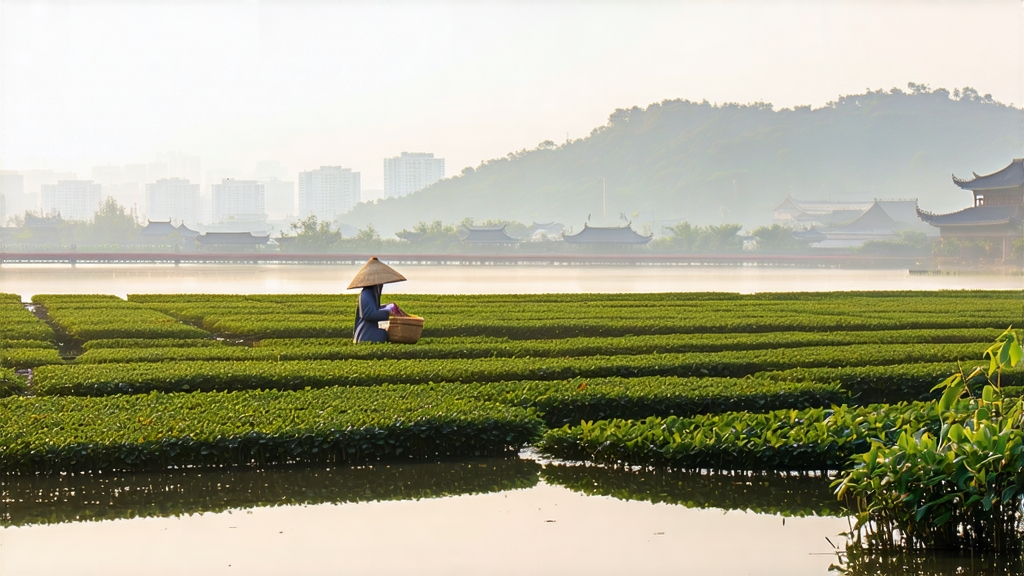
Longjing, romanized as Lung-ching and literally translated “Dragon-Well,” is the most celebrated green tea in China and the benchmark against which all other pan-fired greens are judged. Its fame stretches back more than twelve centuries, yet every spring the same question echoes across the hills that cradle Hangzhou’s West Lake: has this year’s Longjing captured the elusive balance of chestnut sweetness, orchid fragrance, and jade-green clarity that once seduced the Qianlong Emperor? To understand why an entire city holds its breath for a leaf, we must travel from imperial legend to microscopic enzyme, from the skilled wrist motion of a master fryer to the quiet ritual of a gaiwan on a foreign kitchen table.
Historical tapestry
The earliest written record appears in the Tang Dynasty “Classic of Tea” (c. 760 CE), but Longjing’s mythic moment arrived in 1751 when Emperor Qianlong, touring the south, allegedly plucked shoots himself beside Lion Peak and presented the bushes to his entourage. He declared the spring at Dragon-Well auspicious; the name stuck, and the 18 trees he anointed still survive as living monuments. During the late Qing the tea became tribute, carried by canal and horseback to Beijing within days of picking. In the Republican era it dazzled foreign visitors to Shanghai who smuggled small tins past customs; in 1949 it was gifted to Stalin; in 1972 Nixon received 50 grams—an ounce of diplomatic jade. Today the Protected Origin system restricts the name “West Lake Longjing” to 168 square kilometres of Zhejiang hills, yet the cultural aura radiates worldwide.
Terroir and micro-climate
The West Lake basin is a drowned river valley whose granite slopes drain quickly, forcing roots to dive deep for water laced with quartz-derived minerals. Morning mist from the 6 km² lake filters ultraviolet light, lengthening the time chlorophyll breaks into amino acids, especially L-theanine, which translates into sweetness on the palate. Average spring temperatures oscillate between 10 °C at dawn and 18 °C at noon, slowing growth so that two leaves and a bud can accumulate soluble sugars for up to ten days—an eternity compared with the five-day cycle in lowland plantations. The result is a leaf that is thin yet waxy, matte on the underside, glossy on top, and so tender it can be snapped between two fingers without tearing.
Cultivar hierarchy
Within the protected zone three biotypes dominate. Qunti, the ancient open-pollinated population, yields small, pale leaves with high aromatics but modest yield; it is the connoisseur’s choice. Longjing #43, a 1987 clonal selection, buds ten days earlier, offers uniform emerald coloration and resistance to grey blight, making it the backbone of commercial grades. Jiahe #1, released in 2005, sacrifices some fragrance for frost tolerance and is planted on north-facing slopes. Each cultivar responds differently to pan-firing temperature, so a master processor keeps three thermometers and two clocks within arm’s reach.
Harvest calendar
The picking window is brutally short: from Qingming (early April) to Grain Rain (late April), roughly twenty days. Pre-Qingming leaves contain 4 % amino acids and less than 14 % polyphenols, yielding a brew that is almost umami-broth; after Grain Rain the ratio reverses, giving astringent backbone suitable only for second-grade market. Experienced pickers use a “lion’s paw” grip—thumb and index finger pinch the petiole while the middle finger flicks upward, preventing bruising that would oxidize edges. A top worker gathers 600 grams of fresh leaf in eight hours, enough for 150 grams of finished tea, which retails for the price of a Michelin dinner.
Pan-firing choreography
Within minutes of plucking, the leaf is spread 3 cm thick on bamboo trays to lose surface moisture; this withering reduces grassy notes. The critical stage is qing guo, “killing the green,” performed on a cast-iron wok brushed with tea-seed oil and pre-heated to 180 °C. The master tosses 250 g of leaf, using only the radial side of the hand to avoid fingernail tears. In 90 seconds the temperature drops to 80 °C as enzymes denature; the leaf is then rolled against the wok wall with a whispering pressure that sets the